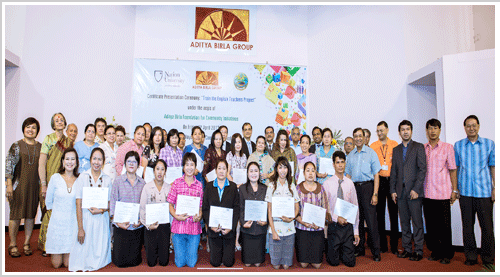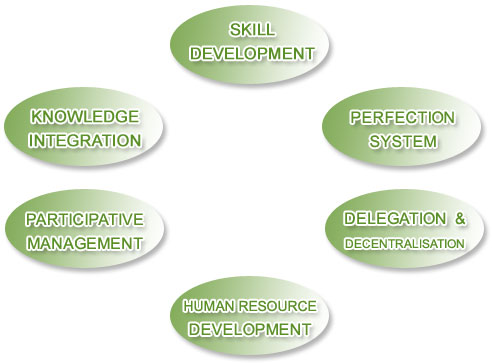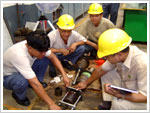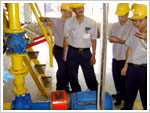|
| |
 |
| Human Resource / Careers > HR Management Policy |
|
 |
|
 |
|
POLICY NO. 1 BIRLA GROUP'S PHILOSOPHY, POLICY
CONCEPT, AND DIRECTIVE PRINCIPLES
OF HUMAN RESOURCES.
PHILOSOPHY OF BIRLA MANAGEMENT CENTRE

PHILOSOPHY BEHIND THE LOGO
The philosophy of the Birla Management centre is beautifully captured in its symbol. The logo has been designed to reflect the concept of group dynamics and group synergy six symbolic persons, one in dark blue and five in light blue,denote one group with various constituents of the group, All fusing their energies and knowledge to form a strong nucleus. The skills of the units merge together and radiate outwards more forcefully.
The arrows pointing inward denote pooling of resources and knowledge.The arrows projecting outwards reflect the dynamic expansion and growth the various units of the group in various industries, globally.
Furthermore, the arrows also symbolise the six specific steps aimed to our motto.
Excellence and perfection in all spheres of management by continous
THE SIX SPECIFIC STEPS TO ACHIEVE MANAGEMENT GOALS
- Participative management by consensus & consultation through (PMC)
I Management committees
II Shop floor committees
III Quality circles.
- Knowledge integration programme (KIP).
- Skills development programme (SDP).
- Systems perfection (SP.)
- Delegation & Decentralisation (DD).
- Human resources development (HRD).
The soft and subdued colors have been specially chosen to reflect the low key profile adopted by the group.
Let us keep the wheel moving
Top
POLICY NO. 2 HUMAN RESOURCES MANAGEMENT POLICY
& MANUAL PRINCIPLES
The basic human resources management policy is to conduct
its relation with its employees in such a way that the company will have
at all times and adequate force of competent and satisfied employees to
conduct all its operations effectively and harmoniously in order to achieve
costomer’s satisfaction at the end.
The human resources management policy is prescribed on the basic of policies formulated by its top management. Such policies are tools of management to understand the consequence of activities and also help all employees understanding.
PURPOSES :
- The policy is a general plan of action that serve as a guide line
- The policies make up the framework of management for following up and decisions.
- When policies are statement of what management wants to do in running the organization, management rightly expects strict adherence to them.
- For the way or guideline for implementing the personnel Management activities for instances employee recruiting, hiring, separation, fringe benefits, training, development, evaluation, demotion, transfer, wages and salaries, grievances, discipline, medical care, retirement, hospitalization, recreation, employee’s relations and other.
- The operating management and supervisor at all levels should know what top management want, and it has to be written clearly in order to avoid misunderstanding.
- When the policy and procedures needs to be clearified, the human resources department will have to administer, implement and interpret policies and take action effectively.
- The policy and procedures is not only to be prescribed by top management but also by the law, culture and employment condition agreement with Labour Union as well.
THE PRINCIPLES OF HUMAN RESOURCES MANAGEMENT POLICIES.
- EMPLOYMENT
The company will try all possible efforts to employ the most qualified and competent employees and retain them as long as possible. Selection and screening will be made on merit basis and unqualified and incompetent applicants will be eliminated.
- COMPENSATION
The company shall pay fair and equitable compensation in accordance with the principle of the employee’s duties and responsibilities, and satisfactory performance, by maintaining its equivalent rate of compensation in comparison to the same or similar type of industry following the Laws, Local practices and
financial stability of the company.
- PROMOTION / TRANSFER
The company to promote the employee from within, the qualified and deserving employees shall be promoted to higher positions whenever vacancies occur or to be transferred to jobs where their talents could be best utilized for higher responsibilities and adequate compensation.
An employee of the company either thru initial appointment or promotion will have to undergo a trial period of 120 days.
A Promotion Means : A movement of an employee to higher level involving more difficult duties or increased responsibilities and a higher pay, higher status or offering better privileges, thus all promotion will be based on merit, good performance and loyalty to the company, such a promotion may be made within the same department or from one department to another.
A Transfer Means : The movement of an employee from one job to another requiring approximately the same degree of skills, duties and responsibilities, and other educational qualification with the same pay scale within the company.
The selection will be made on the basis of qualification for the job through interview, tests, attendance, and job performance.
- WORKING CONDITIONS
A good working condition will bring about a good result to the company and therefore the condition of the working place must be provided with proper working environment and enough safety and at the same time all employees must work with all possible efforts and care in preventing the damage loss or accident to themselves machines and other company property.
-
WELFARE
Good employee benefits will be offered to meet the needs of the employees in accordance with the local or community practice, laws and financial stability of the company. The company will try all possible efforts to look forward to meet the employee requirement in matter of medical care, recreation, hospitalizations and others.
- EMPLOYEE RELATIONS
It is the responsibility of management and executive employees at all levels to point out an employee’s deficiencies and shortcomings so that he may have an opportunity to correct them, and also to promote good Human relations with their subordinates and associates. Everyone must
understand the company rules and regulations and strictly and sincerely follow them. The achievement of the company will be based on the individual cooperation by strict adherence to his/ her duties and responsibilities. Any constructive suggestions and initiatives are always welcome. When an employee is transferred, dismissed, or demoted. He is entitled to know the reasons for the Company’s action.
- TRAINING
The company believes that well – trained employees both technical and administration skill will bring about achievement to the company, and therefore,The company’s employees at all levels will be provided appropriate training course to enable them in developing their ability, knowledge and skills. Both internal and external training including seminars will be provided as the management deems appropriate. It is also a the responsibility of executive employees at all levels to train their subordinates in order to develop the performance of their subordinates and also be account able for the jobs assigned to the subordinates.
HUMAN RESOURCE MANAGEMENT MANUAL (HRMM).
The human resource management manual (HRMM) is a companionvolume to the employee handbook. It presents HRMM policie in details for a particular group of people who have particular responsibilities for communicating them. Carrying them out or putting them into action. The employee handbook is for everybody. The HRMM is written for the guidance of executives and managers primarily.
In short, The HRMM helps the executives and managers understand the objectives of specific policies, interprets key aspects of the policies, defines terms and outlines approved procedures.
THE HRMM THEN, SERVES TWO MAIN PURPOSES
- It provides a written expression of policies to ensure consistent application throughout the company.
- It enables every manager to administer his own employee relations at the most desirable level for first – line supervision.
AN APPROVAL OF POLICIES
The HRMM shall be approved by president. Drafts of HRMM is submitted to executives and other dept. Managers whose functions relate to the Subject/ matter and to operate HRMM. They are expected to Comment on some possible effects, if any, and propose suggestion for revisions. The text then, must
be checked against the employment condition agreement, Working rules, and court decisions by the human resources manager and refer such To the president for review and take appropriate action.
Ultimate approval may reside with top management, I.E., President Labour and approval levels may vary according to subject / matter and the extent of The policy.
However the policies or procedures may be issued as long as it is Not against approved policies.
MANNUAL DISTRIBUTION
In general practice , the HRMM is an official controlled document, distribution is limited, use list is decided by the president and when HRMM is required by others, approval of president is needed.
However separate handbook or circular may be made for all concerned if necessary
HRMM UPDATE
The conditions that call for particular HRMM policies are seldom static. A policy is useful only if it is changed to meet new requirements. A policy changed but not recorded in the manual and not communicated to all
concerned is an invitation to fail. Responsibility for keeping the manual upto date should be assigned to all concerned. For example, the production manager recommends changes in recruiting the chemists in place of engineers. When he obtains approval for such modification, then he is the one who initiate a request for
manual changes. The HR Manager recommends a change of dormitory procedure and when be obtains approval, he is the one who initiate a request for manual change. However, as a rule, such change should not be made officially until it is refereed to a specialist or management of the company.
The manual itself can be used as a vehicle for making changes. The More comprehensive the manual is, the more useful it can be in effecting revisions of policies. Because it is so important that a HRMM be kept responsive to current needs, revisions should be implemented continuously.
In addition to making changes there is a need of some kind of Periodical audit of the entire manual . A good rule is to examine every chapter every year after its issue on last revision. The human resources Manager is responsible to take action in this regard.
COMMUNICATION DEVICE.
Meeting with all dept. managers is necessary before putting
The policy manuals into action or revising then. Misunderstanding and
misinterpretation of the policies are very dangerous, Vice Presidents and
department managers who will execute directly or indirectly these policies
must be fully communicated and they will also further communicate their subordinates in their respective departments.
TRAINING DEVICE
A good HRMM may be the best personnel administration textbook The Managers and supervisory staff will find that these are the nuts and bolts of today’s Personnel theory and practice as applied by the company. It can be the cornerstone of supervisory and management training programs in human relations, case studies,role playing and other problem-solving techniques which can be designed around the policy manual.
THE ROLE OF HUMAN RESOURCES MANAGEMENT
- PREAMBLE
Scientific management can make the tasks of production, purchasing,
Marketing, and accounting almost a matter of routine. Definite procedures can be
Established and op-eration can be performed under controlled conditions so that
They can be easily evaluated. Such matter is not the case with the human resources management, since no formula has yet been found to meet the problems brought about by the relations between the employer and the employees. It is true that in human resources management certain procedures such as employment process or the filing of employee records and reports can be considered as routine work, but in matter dealing with individual employee or with the labour union, there are no rules in order to meet their problems. Each problem may be considered for a particular approach and a particular situation. Business executives found that it is often more difficult to solve human relations problems than technical ones and that HR Management is essentially a human relations problem-solving job concerning with the whole game of human emotions and range of experiences. One of the most knotty probleming in management of labour relations today is how to achieve mutual understands, and adjustments which are brought about by constant changes in a modern business organization. All levels of management, from the president to the lowest supervisory personnel, generally recognize that most of the problems confronting them involve the human resources management. Their solution requires thoughtful attention and careful action, However, such problems of human resources can be more effectively handled with the help of the human resource manager who is a specialist on problems involving men at work. Line supervisors/managers should regard him as an ally, not an enemy. Experience have proved that the functions involved in managing men and women on the job can be carried out more effectively and economically with the assistance of the personnel staffs who are, in turn, conversant with the science and art of personnel management.
- RESPONSIBILITIES.
In actual practice, human resource management is a management
function. This means that everyone (every supervisor/every manager) is indirectly
a personnel man as he has to implement personnel administration policies and
programs conducive to his respective department or section. At the top level
(president and vice- president) emphasis would be on policy making and planning,
where as the middle management level (Dept. Manager, Ass’t Mgr. Or
Superintendent) emphasis would be on developing subsidiary plans and
implementation of policy and objectives. And at a supervisory level (Shift engineer,
Supervisor or foreman) emphasis is entirely on implementation and control measures
to see that the HR administration policies and programs are properly managed or
carried out. The human resource department, However, serves as staff (who advises,
assists and services) to all levels and the top HR Dept. man should be a part of
Management team.
- THE MANAGEMENT OF HUMAN RESOURCES MANAGEMENT (HRM) DEPARTMENT.
As HRM is a management function as stated above, the basic management function of the human resource department can be given briefly.
PLANING
In HRM, planning refers to the formulation of personnel administration Policies, and functions to achieve the goals of the company.
ORGANIZING
In HRM organizing refers to the arrangement and relationship of necessary activities, division of work, line of authority and communication system established to get the work done at specified time.
DIRECTING
Is concern with the guidance of all efforts toward the objective.
It provides a means of putting plans into action through effective supervision,
work rules and procedures. Effective communication among the personnel staff
can also be a means in carrying out the tasks of directing. If the personnel staff
knows exactly their duties and responsibilities, they can work with greater efficiency
and accomplish more.
CONTROLLING
When the program has been implemented, changes or deviations may have to be reviewed and corrected when necessary. The control system will show whether the personnel program is being carried out satisfactorily as planned or not.
-
OTHER SCIENCES NEEDED IN THE STUDY OF HUMAN RESOURCES.
Apart from the political related to personnel administration, other
Fields of study can contribute to the understanding and developing the personnel.
Administration on entering personnel should be acquainted with the basic
knowledge of related fields, namely, psychology, economics law, politics, research,
statistics, religion, culture and behavioral science, all these sciences are directly
related to the administration of human resources.
- RESPONSIBILITIES OF HUMAN RESOURCES MANAGEMENT
DEPARTMENT
Generally, The major responsibilities of the HRM include.
1)
Developing personnel programs and policies after the approval of top management, administering them: The personnel staff help explain and interpret management policies to employees and bring to management's attention the employee's views on those policies and programs to avoid any communication gap between management and employees. The human resources manager makes sure that the personnel policies and programs polices are implemented to meet the needs and demands of changing situations.
2)
Assisting line management on personnel matters this assistance may be provided through:
(a) Employee recruitment, selection, hiring and placement.
(b) Determination of skills available in the work group.
(c) Employee counseling and problem solving.
(d) Employee benefits and services.
(e) Medical and hospitalization facilities.
(f) Encouraging safety and on the job injury prevention.
(g) Employee training and development.
(h) Employee suggestion system.
(i) Labour relations problems-solving.
(j) Total quality management (TQM).
(k) Total productive maintenance (TPM).
3) Assisting line management in rating the employee's performance
One of important tasks of HRM department is to assist line manager/Supervisors in evaluating the performance of the employees under their supervision. The appraisal forms and rating techniques are formulated and appraisers & appraises are trained.
4) Coordinating HR administration activities.
(a) Employment-recruitment, selection and placement.
(b) Promotion, transfer, lay-off, discipline, absenteeism etc.
(c) Training & development of supervisors.
(d) Fringe benefits and services.
(e) Setting salaries and wages rates.
(f) Employee motivation and morale development.
(g) Health and safety and on the job injury prevention.
(h) Communications.
5) Job evaluation and classification
The HR. dept. studies and evaluates the jobs in the firm through job analysis and job evaluation. It recommends job classification and the establishment of a sound wage and salary structure, it administers the company's policies governing wages and salaries.
6) Employee relations
This is one of important functions of the HR department in the area of negotiation, interpretations, and administration of management labour union employment condition agreement. HR department must use its utmost tact diplomacy in dealing with the labour union
Top
POLICY NO. 3 COMPANY STRUCTURE
In well-organized organization the unity of command and
delegation of authority are very much essential. No employee can work successfully
for more than one immediate superior at the same time. A subordinate who receives
conflicting orders from more than one superior is likely to be confused, irresponsible
and inefficient, and our organization charts have to be made clearly in accordance
with principles of good organization.
Delegation will bring about organization success
Delegation
Give the executives an opportunity to take an additional work of high importance for instance planning, organizing, staffing, controlling, motivating and coordinating.
Delegation
Relieves them of petty, routine details that can be done by others.
Delegation
gives subordinates a chance to use their initiative and judgement.
Hence authority and responsibility of every superior shall be
clearly spelled out in writing and properly communicated to all concerned. Each employee in the company must know to whom
he reports and who are under his supervision. Through this,
jurisdictional disputes shall be minimized.In order to carry out assigned tasks, responsibility requires commensurate authority, responsibility without authorityresults in chaos. However, the following phase should be eliminated that “Officers seek authority but shirk responsibility”. This results in buck-passing and ends in inefficiency.
To be effective, the following devices will be used to effectively carry out the Delegation of authority, one of important philosophies of the company.
Organization charts.
Written regulations/orders.
Job descriptions of key positions.
Authoritative manual.
Human resources management manual (HRMM).
To the above questions, the flip answer is "it all depends" with criteria;
- Competence to make a decision on the part of the person to whom the authority is delegated and also confidence in that competence on the superior.
- Scope of impact of decision which effect the men, money or material within and without his own department. Any decision which may effect more than one department rests with the higher authority than department head.
- A reliable and adequate information to make a decision for some special case of unroutine nature. However, a the rule, the accountability of higher authority for the acts of its subordinates is absolute.
Top
POLICY NO. 4 ORGANIZATION CHARTS
Objective
An Organization chart.
Helps the management to apportion the various duties or functions in order that they will be performed with a minimum of waste.
An organization chart.
Helps to visualize the company structure (as stated under policy no.2)as whole. It portrays the principal divisions and lines of formal authority and responsibility.
An organization chart.
Is similar to an architect's blueprint of the house, in showing exactly the responsibility of each person in the company.
An organization chart.
Is a communication system for assigning work, giving out jobs, delegating authority, fixing responsibility, and receiving information or results.
PRINCIPLES OF GOOD ORGANIZATION
Objectives
- The objectives of the enterprise and its component elements should be clearly defined and stated in writing, the organization should be kept simple and flexible.
Activities
- The responsibilities assigned to a position should be confined as far as possible to the performance of a single leading function.
- Functions should be assigned to organizational units on the basis of homogeneity of objective to achieve most efficient and economic operation.
Authority
- There should be clear lines of authority running from the top to the bottom of the organization and accountability from bottom to top.
- The responsibility and authority of each key position should be clearly defined in writing.
- Accountability should always be coupled with corresponding authority.
- Authority to take or initiate action should be delegated as close to the scene of action as possible.
- The number of levels of authority should be kept to minimum.
Relationships
- There is a limit to the number of positions that can be effectively supervised by a single individual.
- Everyone in the organization should report to only one boss.
- The accountability of higher authority (higher boss) for the acts of its subordinates is absolute.
By Harold steiglitz, organization planning, handbook of modern personnel administration, published by JOSEPH J. Famularo, Vice President, personnel relations, MS. GRAW-HILL, INC.PP, 3-8.
In order to meet the above objectives, the following existing organization charts are made.
- Master organization chart.
- Human resources management department chart.
- Human resources management functional chart.
Top
|
|
|
 |
|
 |
|
 |
 |
 |
| Quality Circle |
| At Thai Rayon, we be believe that our people are number one asset and a resource that will continuously be developed and provided the opportunity to share ideas for improvement of their organizations. More |
|
|
 |
 |
|
 |
 |
| Training and Skill Development |
| At Thai Rayon , training and skill development programs are provided to all level of employee in order to develop capability of all employee to effectively master their own function as well as creating multi-skill personnel More ... |
|
|
 |
|
|
